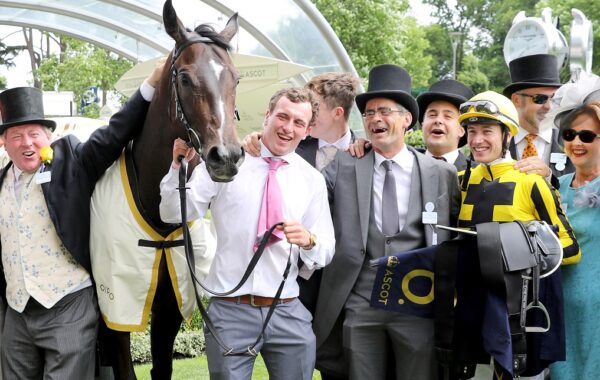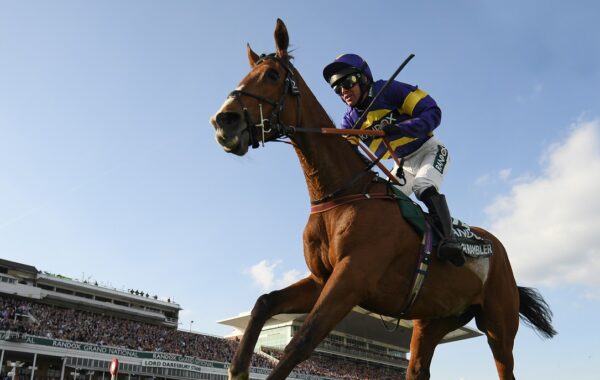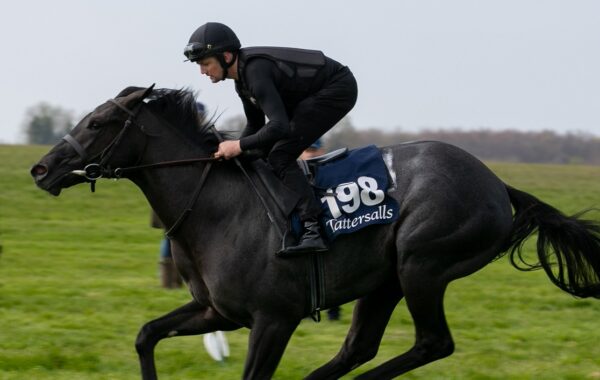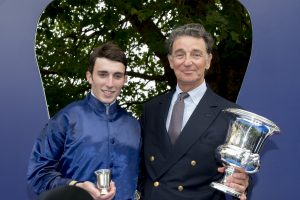In March – a time when the majority of your string are in exercise only – you won the Dubai Sheema Classic with Postponed. What challenges are there in getting a horse to peak early?
You must be organised. The plan to run in Dubai has to be set in motion in the autumn/early winter. You need time to prepare the horse for a Dubai campaign – it cannot work as an afterthought.
Horses thrive going into the warmer weather and it has never proved to be a problem sending a horse from a cold climate to a warm climate.
Is there more improvement to come with this five-year-old and will he be trained with an international or domestic campaign in mind?
It is possible that Postponed is still improving as the progeny of his sire Dubawi tend to get better with age. He looks to me like a horse in his prime. Postponed will have a summer campaign leading up to an attempt at defending his King George crown and it is likely his next target will be the Coronation Cup at Epsom.
I believe good or faster ground is key to seeing him at his best. It is too soon to be making plans regarding domestic or international plans in the autumn.
Sheikh Mohammed Obaid Al Maktoum moved Postponed and around 30 other horses to your stable from Luca Cumani, which prompted plenty of discussion in the press. How do you deal with these situations?
Owners pay the bills and they have the right to move their horses to another trainer if for some reason they are not happy; it is part of the industry that we have to deal with. This was a high-profile move that naturally gained media coverage.
Most important for me was to be honest and respectful to the people closely involved with the change of circumstances, the owner Sheikh Mohammed Obaid and trainer Luca Cumani. I spoke with Luca at length one evening, some considerable time before the story broke. He could not have been more of a gentleman. I admire him for that.
As a youngster you were committed to jumping, spending time in the point-to-point yard of Alan and Lawney Hill, riding seven winners during a three-year spell with Josh Gifford and even three winners as a conditional in Maryland. What brought about the switch to the Flat?
I became very interested in Flat racing while I was at Josh Gifford’s. I enjoyed reading the pedigrees and got hooked one year watching the build-up to the Guineas. I was fortunate that Josh did not entertain summer jumping so I got a good summer holiday every year and went straight to Newmarket to spend time working for Michael Jarvis.
After I got hurt in a fall in America, Michael offered me the role as his assistant. I didn’t need to think twice before taking him up on the offer.
I am ambitious – I always have been. What excites me is seeing the buzz and ambition from the team around me. I believe this game needs to be shared
In which ways did your early jumping experience prepare you for life as a Flat trainer in Newmarket?
I worked for Josh Gifford between 1998 and 2001. It was a great time in Findon and Josh was a gentleman to work for. He was a hard taskmaster but wanted the lads to enjoy themselves, too. It was a great place to learn some valuable ‘life’ lessons; I was much the wiser leaving Findon than I was when I arrived.
Being exposed to jump racing gives you a level of horsemanship that stands up whatever sphere of the industry you’re in, be it sales, breeding or training.
This season you are training around 200 horses, possibly the largest string in Newmarket. Can you explain what excites you about the responsibility of being in charge of so many horses?
I’m not sure we are the biggest string in Newmarket, but it’s great we have a large and healthy number of horses. I am ambitious – I always have been. What excites me is seeing the buzz and ambition from the team around me. I believe this game needs to be shared. Training a large number of horses, I get to enjoy the action with many different people – owners, staff and family alike.
Promoting the sport in the public domain is important, too, and the British media covers racing well. But I would love to see racing receive more colour and space in the dailies, particularly in the immediate build-up to big races. That would develop a national level of interest, as it does in some other racing nations.
In Japan, for instance, racing is the third biggest sport behind football and baseball, and is portrayed that way. Here racing always seems to be elbowing for space between other sports.
Is there also a degree of trepidation with training such a big string?
I don’t have any negative feelings about training a large string. We are in a privileged position and any added pressures should be embraced. Last winter we worked on developing the team and structure of the business in order to deal effectively with a large number of horses.
A business should be able to cope with growth but it is important to have key personnel in key positions, otherwise you find yourself swimming up hill. Fortunately, we have a great team from the bottom to the top with some very good managers. As a trainer you have to find the right staff; when you do, you have to trust them and delegate.
How tricky was the transition from offering opinions as an assistant to making the decisions as a trainer?
Unfortunately for Michael his health was deteriorating during his last season training, which meant I took on more responsibilities than a regular assistant trainer would normally do. This was a sad time for the boss but it meant that when I took over the licence the transition was less of a culture shock than perhaps it might have been.
Of course, when your name is on the licence you’ve got to get used to new pressures and you find out quickly the buck stops with you. I was very conscious that I had nothing to fall back on if things didn’t work out. I was anxious to do Michael justice and prove to the outside world that I was the right man to be taking on the job.
What important lessons did you learn during your time with Jarvis?
I was incredibly lucky to work under Michael for ten years. He was a gentleman from the day I met him until the day he died. He was unflappable and so calm in any situation. Michael was also seriously competitive, which was sometimes lost on people because of his relaxed demeanour. I was spoilt to have him in my corner for the first six months that I trained.
Starting off as a salaried trainer, you always said you wanted to have your own business. Are you any nearer?
I was a salaried trainer for the first two years I was training, and I couldn’t have scripted a better way to start. It allowed me to concentrate on the horses and the owners without the stress of managing a business. But after two years the time was right for my wife Hanako and I to set up our own business and we have since leased Kremlin House Stables from Michael’s widow, Gay Jarvis.
Varian Stables Ltd started trading in the spring of 2013. The effort put into training horses, the combination of hard work, success and failure, is something that becomes very personal to the trainer because you invest your entire life in this industry.
Andrea Atzeni and Harry Bentley are on board this season, but both with separate retainers. How will your jockey set-up work?
I wanted a jockey structure that will allow for consistency. Andrea is employed by Sheikh Mohammed Obaid and will ride for him before anyone else. I’m sure he will also have plenty of opportunities to ride for my other owners and I’d like him to be on as many of my horses as possible. He’s an exceptional talent. Harry has a contract with HH Sheikh Mohammed bin Khalifa Al Thani and will ride for him before me.
However, Sheikh Mohammed bin Khalifa Al Thani does not have a vast string and I think Harry will ride for me very regularly. I think he’s in a good position to take the next step forward in his career. This could be his breakthrough year; I’m certain he will be in demand from a number of other trainers.
I also have a lot of time for Jack Mitchell. He rides out regularly, works hard and deserves his chances. His confidence is high after a good winter and I hope his outside support picks up as well.
You acknowledge the importance of global competition and, with your Japanese wife Hanako, do you have long-term ambitions on the massively endowed big races in Japan?
With the help of Hanako I have learnt a lot about Japan and met a lot of the Japanese racing personalities including owners, trainers and jockeys. It is an ambition to train a Group 1 winner in Japan.
My brother-in-law, Mitsu Nakauchida, trains in Japan and is doing very well. Racing in Japan is an amazing experience. The tracks regularly attract over 100,000 fans and it is a hugely popular sport. It is no coincidence they are enjoying global success.
Does Hanako, who has presented you with a daughter, Momoka, and a son, Eiji, play a part in the running of the yard?
Hanako knows me better than anyone and has had a huge influence on my career, although she has not been seen in the yard as regularly as you might think. She has had a full-time job working for Darley Japan, which is due to finish on May 1. So we are likely to be seeing more of her.
Training horses does not allow much time out, but we are family people and any spare time is happily spent with the kids. They are 4 and 2, and very funny at that age.
I think the balance is fine, but I’d not want to see too much more all-weather during the turf season. The all-weather is an important tool for educating maidens over the winter
There has been lots of talk about a lack of suitable employees in our sport. How easily have you found recruitment and retention of staff?
Racing is a labour-dependent industry and is not the only one having difficulties with staff recruitment and retention. It’s tougher finding staff in winter when the days are short and it’s not so glamorous, but once into April there are more staff available, particularly those used to working in warmer climates.
I think, as an employer, your team needs to know that you generally care about their input and also their wellbeing. Everyone has a different role to play within the operation and if people feel valued they will give you so much more. I am lucky to have a great team.
You campaigned Kingston Hill through the 2014 Triple Crown programme of the Guineas, Derby, St Leger and he did you proud, finishing eighth, second and first, respectively. Is there still a place for our Triple Crown?
Our Triple Crown will always be harder to achieve than the US equivalent due to the variation in distances and dates. When we ran Kingston Hill in all three Classics I was surprised how few horses had tried to do it over the years. I am sure that with more suitable underfoot conditions Kingston Hill would have gone closer to winning the Triple Crown.
Camelot nearly achieved it in 2012 and that created huge excitement throughout the sport. At some stage a superstar will come along with all the qualities to win the Triple Crown and hopefully connections will give it a go. There is nothing like witnessing a genuinely special horse being given the opportunity to create history. And the commercial benefits to our sport would be huge.
You are a big competitor on the all-weather. Is there a tipping point in terms of the number of fixtures (versus turf) and are we close to it?
I think the balance is fine, but I’d not want to see too much more all-weather during the turf season. The all-weather has become a particularly important tool for educating maidens over the winter. Before the proliferation of all-weather racing, trainers were forced to rush backward two-year-olds into useful autumn maidens or wait to gain experience in the spring.
Now we are seeing a number of top-quality horses make their debuts over the winter. Look at Jack Hobbs, who went on to win the Irish Derby after making his debut at Wolverhampton on December 27. The all-weather experience has to be helpful to trainers, particularly as four of the five Classics are run early.
Do you get involved in racing politics, or the local Newmarket community?
I try to keep up with racing politics, although it is not always easy as it is an ever-changing and complicated beast. It is my understanding that we have got some great minds currently leading us in Nick Rust and Steve Harman. It is important that we get behind them.
Give us a two-year-old, three-year-old and older horse to follow this season…
My two-year-old is Zeelander, a Dubawi colt and late summer/autumn type. My three-year-old Ennaad, who completed his hat-trick on the all-weather at Kempton over Easter, should keep improving and may go for the Heron Stakes at the end of May. My older horse is the aforementioned Postponed, who we hope will keep improving through the summer.
Do you consider the replacing of 90% of maiden races with novice events to be a good thing for the sport?
I can see the logic in the changes, as under the old programme there were limited chances to run first-time-out winners before Royal Ascot and the start of the nursery programme in July. Now trainers who have prepared a horse to win on debut have the opportunity to get more experience into the horse before tackling stakes company.
I won’t be too affected by this early- season change, as I don’t run many five- or six- furlong two-year-olds. But I think a key factor will be how many juveniles will be able to defy a penalty, and whether or not asking a young horse to concede 7lb is too much.
On the other hand, some trainers might be exasperated at having to tackle a wide-margin first-time-out winner, even in receipt of 7lb. There is no doubting the programme is radical. Time will tell if 90% was too drastic a change too soon.
Your first runner, Laaheb, was fourth in the Dubai Sheema Classic, a race you won this year. Evaluate your first five years in the job, and what would you like to achieve in the next five?
Ups and downs but generally progressive. The graph is pointing in the right direction, which is the most important thing. The first five years have gone some way to cementing foundations, but you cannot take anything for granted and hopefully the next five years will prove that the first five were no fluke.






